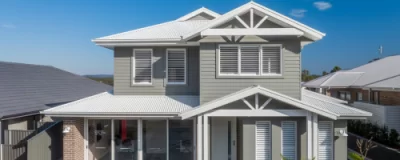
Why invest in new build property?
Investing in newly built homes is a fantastic opportunity for anyone looking to step into the real estate market. These new constructions come with modern amenities, energy-efficient features, and often have lower maintenance costs compared to older properties, making them highly appealing to renters.
The process is straightforward and gives you a lot of control, with clear stages like site meetings, weekly updates, and key milestones, all backed by construction loans that align with progress payments. This approach can make the journey smoother and more predictable, which is a big win for investors.
The property market in Australia, especially New South Wales, has been steadily growing. New developments in booming suburbs present exciting opportunities for smart investors. By doing thorough research, planning your finances wisely, and teaming up with a trusted builder like Domaine Homes, you can be confident that you're making a great investment in an area that's set to grow.
When thinking about investing in a new build, it’s important to consider things like location, local amenities, and transport links.
What are you looking for today?
Benefits of New Build Investment

High Rental Demand / Rental Income
Newly built homes often attract high-quality tenants who are willing to pay premium rents for modern amenities and contemporary interiors. In a competitive rental market, new properties stand out because of their appeal and up-to-date features. These properties typically draw in professionals or young families looking for low-maintenance, comfortable living spaces.
The attraction of modern appliances, sleek designs, and energy-efficient features makes these homes especially desirable to renters who appreciate style and comfort. This high demand can lead to shorter vacancy periods and more consistent rental income for you as an investor.
Many new developments are strategically located near transport hubs, employment centres, and lifestyle amenities. Being in these prime locations boosts rental demand, allowing you to secure higher rental income.

Potential for Capital Growth
New build properties have significant potential for capital appreciation, especially in growing areas. Selecting appropriate home designs can enhance land value and overall property value. As neighbourhoods develop and mature, property values often increase, benefiting early investors.

Tax Advantages
Investing in new builds can also bring you substantial tax benefits. You can claim depreciation on both the building's structure and its fixtures, reducing your taxable income. The Australian Taxation Office offers higher depreciation rates for new properties compared to older ones, which can mean significant tax deductions, especially in the early years of ownership.
There are also potential savings on stamp duty, with some states offering reduced rates or concessions for off-the-plan purchases. Additionally, you may qualify for negative gearing benefits if your property's expenses exceed its income, providing valuable tax relief while you wait for capital growth or rental increases.
Financing Your Property Investment
When it comes to financing a new build property investment, there are several options available to suit diverse needs. Understanding these options can help you make the best choice for your financial situation and investment goals.

Loan Options
There are various loan options for financing new property investments in Australia, including construction loans and standard home loans. Construction loans are specifically designed for new builds, allowing you to draw funds in stages as the construction progresses. These loans often have interest-only repayments during the building phase, which can help manage your cash flow more effectively.
Another option is a standard home loan, which might be suitable if you're purchasing a completed new build property. Some lenders offer package deals that combine both construction and standard home loans, providing flexibility as the project moves from construction to completion. Interest-only loans can also be considered, offering tax benefits and lower initial repayments. However, it's essential to think about the long-term implications of this approach to ensure it aligns with your investment strategy.

Government Grants and Incentives
The Australian government offers a variety of grants and incentives to encourage new build property investments. The First Home Owner Grant (FHOG) is available in most states and territories, providing financial assistance to eligible first-time buyers looking to purchase or build a new home. Some states also provide additional incentives, such as stamp duty concessions or rebates for new builds, which can significantly reduce your upfront costs.
The HomeBuilder grant, introduced in 2020, offers further support for new home construction and substantial renovations. Investors should also explore tax incentives, like depreciation benefits, which can be particularly advantageous for new build properties. Negative gearing remains a popular strategy, allowing investors to offset losses against other income, providing potential tax relief.
Don't know where to begin, contact us today to get started!
Location
Where to build

Build Map

Contact Us

Display Locations
Alternatively, speak with our consultants today to help you find the right property and location to maximise your investment.
Frequently Asked Questions
Investors in new-build properties can claim depreciation on both the building structure and fixtures. This allows for higher tax deductions compared to older properties. Stamp duty savings may also apply in some Australian states for off-the-plan purchases.
Capital works deductions can be claimed for the building's structure over 40 years. Plant and equipment items like appliances and carpets can be depreciated more quickly, boosting tax benefits in the early years of ownership.
Investors in new-build properties can claim depreciation on both the building structure and fixtures. This allows for higher tax deductions compared to older properties. Stamp duty savings may also apply in some Australian states for off-the-plan purchases.
Capital works deductions can be claimed for the building's structure over 40 years. Plant and equipment items like appliances and carpets can be depreciated more quickly, boosting tax benefits in the early years of ownership.
Investors in new-build properties can claim depreciation on both the building structure and fixtures. This allows for higher tax deductions compared to older properties. Stamp duty savings may also apply in some Australian states for off-the-plan purchases.
Capital works deductions can be claimed for the building's structure over 40 years. Plant and equipment items like appliances and carpets can be depreciated more quickly, boosting tax benefits in the early years of ownership.
Investors in new-build properties can claim depreciation on both the building structure and fixtures. This allows for higher tax deductions compared to older properties. Stamp duty savings may also apply in some Australian states for off-the-plan purchases.
Capital works deductions can be claimed for the building's structure over 40 years. Plant and equipment items like appliances and carpets can be depreciated more quickly, boosting tax benefits in the early years of ownership.
Investors in new-build properties can claim depreciation on both the building structure and fixtures. This allows for higher tax deductions compared to older properties. Stamp duty savings may also apply in some Australian states for off-the-plan purchases.
Capital works deductions can be claimed for the building's structure over 40 years. Plant and equipment items like appliances and carpets can be depreciated more quickly, boosting tax benefits in the early years of ownership.






















